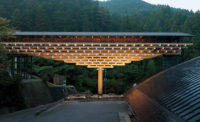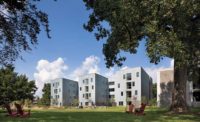On February 2, a new elementary school designed by New York–based Toshiko Mori officially opened in the remote west Senegalese village of Fass—the first in a region, consisting of 110 villages, to teach children how to read and write in their native language, Pulaar, as well as French.
The landmark school represents seven years of negotiations with local Muslim leaders and Nicholas Fox Weber, the executive director of the Josef and Anni Albers Foundation and founder and president of Le Korsa, a nonprofit dedicated to creating medical centers and schools in Senegal. The sensitive discussions resulted in an agreement that the Fass School would teach boys and girls literacy, practical skills like sewing and carpentry, physical education, and history, while continuing traditional Quranic instruction.
Additional Content:
Jump to credits & specifications
“One of the things that’s made Toshiko so great for this project is that she sees architecture as a big vision—its impact on humanity—not just building buildings,” says Fox Weber. The Fass School can serve up to 300 students from ages 5 through 10.
Mori designed an oval building with an inner courtyard for the school, borrowing its shape from an ancient compound in the region, and used the local workers with traditional skills and materials to build it (a necessity since it is located seven hours from Dakar, across the Gambia River). Small steel members and bamboo support mud-brick walls, painted white to deflect the sun’s heat. The structure has a bamboo and grass-thatched roof, the outer ring draping the exterior walls, the inner dipping to leave the courtyard open but partly shaded, with the two joining in a ridge above the enclosed areas. Mori inserted six interior walls within the “donut” to create three classrooms and three indoor-outdoor spaces.
The roof shape is a parametric inversion of the traditional pitched one. It helps divert rainwater from flash floods into a channel that encircles the building and empties belowground toward an existing aquifer. A similar, smaller structure on the site provides housing for two teachers.
The materials and forms are ones that Mori explored in her award-winning Thread project, also funded by the Josef and Anni Albers Foundation and Le Korsa, and located about an hour’s drive from Fass in Sinthian. The artists’ residency and cultural center complements existing medical clinics, a kindergarten, and a farming school on the site. Its name was inspired by Anni Albers’s work as a textile designer and weaver.
The Fass School design, essentially a one-room schoolhouse, was also inspired by the Alberses, says Mori, because Josef had previously taught in one himself. Mori imagines the school as a place for members of many local tribes to come together, like a family. The structure creates a comfortable place to learn and take shelter, in an area where temperatures soar. Air circulates quickly and easily around the interior. “We wanted to de-institutionalize school and not make it imposing, scary, or foreign,” says Mori. Quranic studies typically take place in concrete-block buildings with corrugated metal roofs; when it’s hot, the buildings are stifling, and when it rains, the sound drowns out instruction, says Mori.
How does Fox Weber think he was able to ultimately come to an agreement with the community’s leaders to teach literacy in a new school? “They felt my respect,” he says, “and that I was not coming in to tell them I knew better or that I wanted to convert people to another religion. And I think they came to see my motive: quite simply, in the world today, there’s no reason for people not to be able to read or write.”
CreditsArchitect: Toshiko Mori Architect 199 Lafayette St, Suite 5a New York, NY T: 212-337-9644
Personnel in architect's firm who should receive special credit: Toshiko Mori, FAIA Jordan MacTavish, AIA
Engineers Structural: Schlaich Bergermann and Partners
General contractor: Dr. Magueye Ba
Photographer: Iwan Baan |
SpecificationsN/A |












Post a comment to this article
Report Abusive Comment